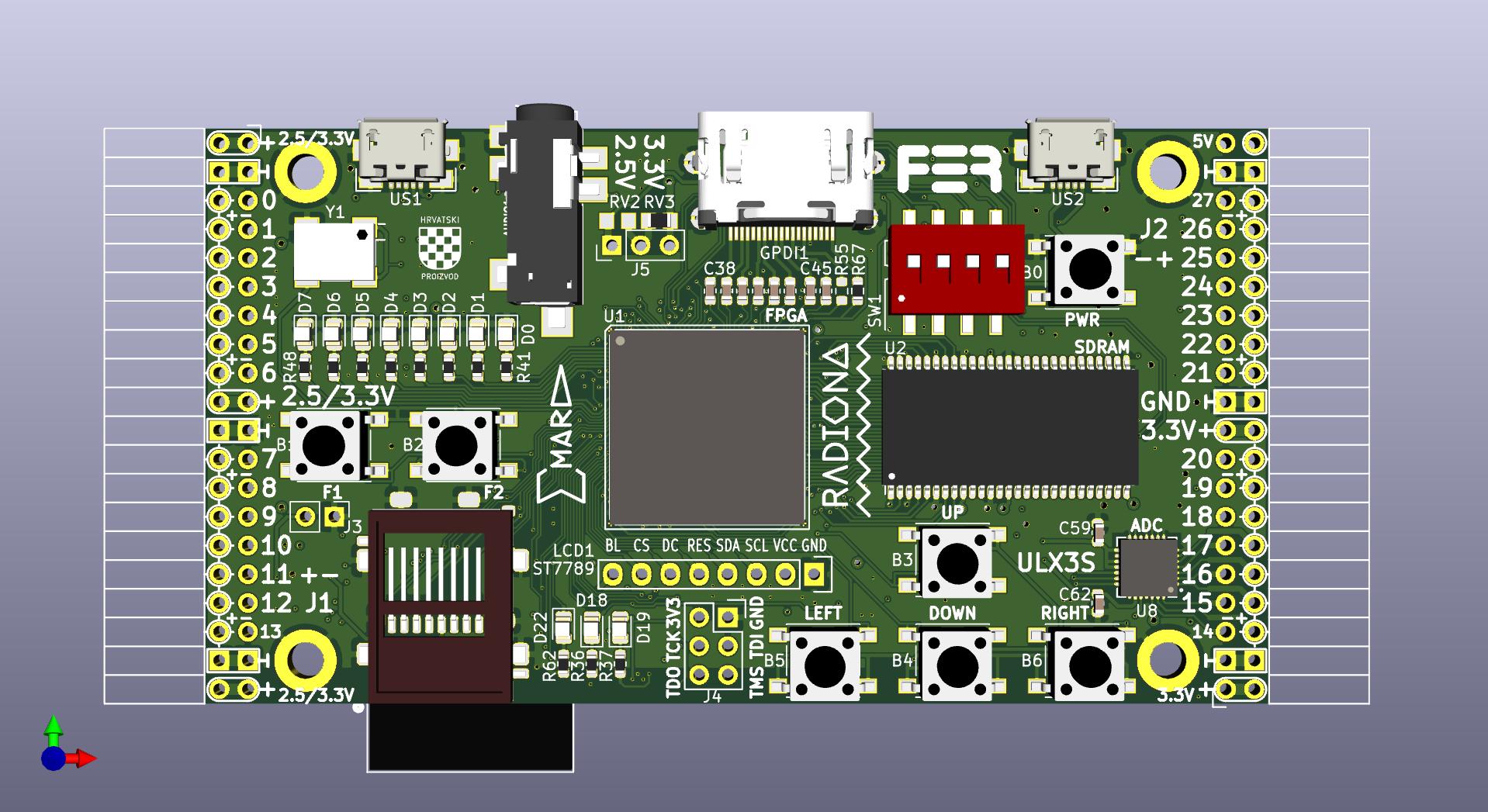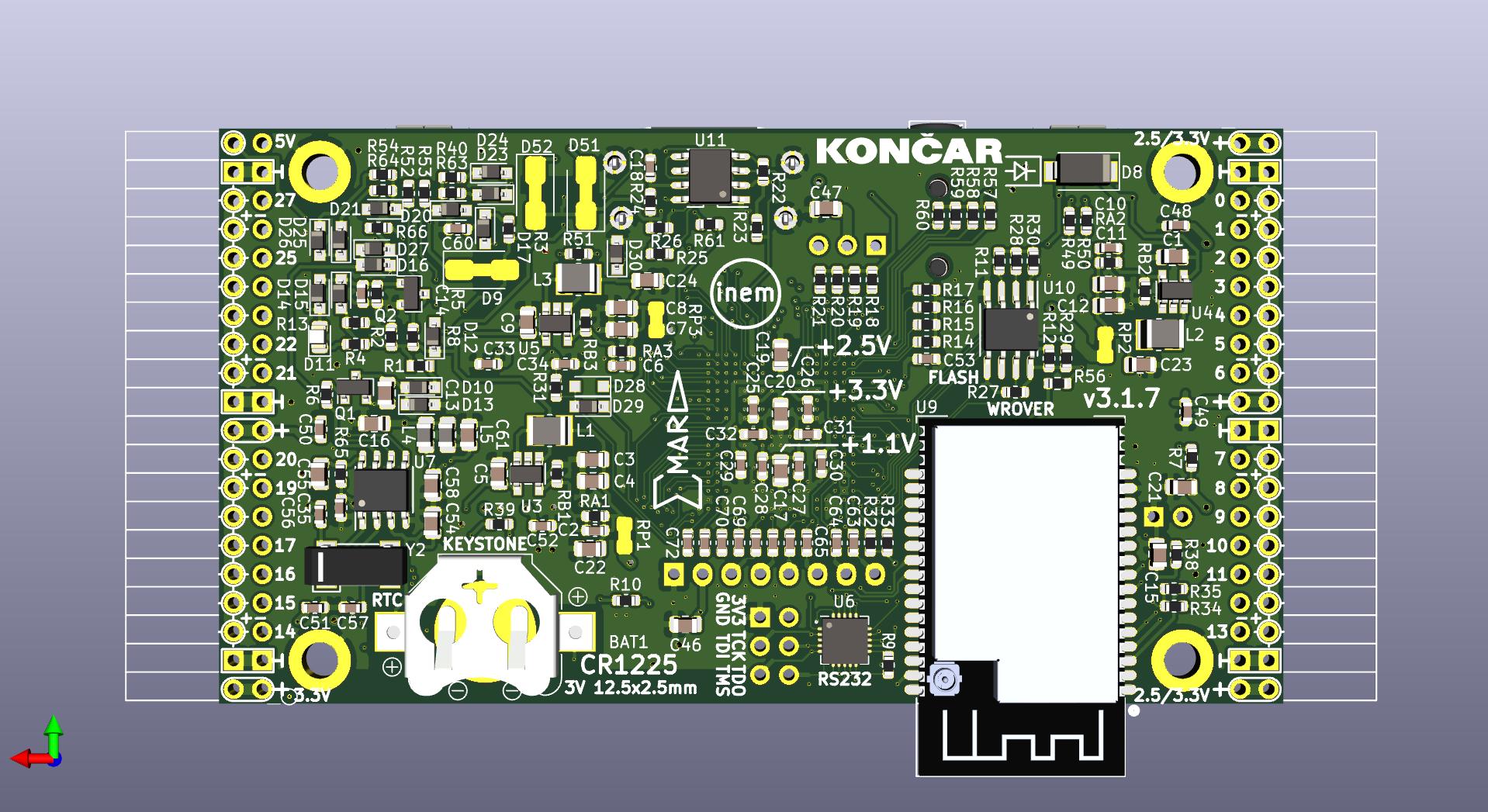Buy Parts
| ... 56 more lines |
| View All |
ULX3S PCB
ULX3S = University digital Logic Learning Xtensible board release 3 with SDRAM, Successor of ULX2S.
Manual *Quickstart Binaries *ULX3S at Kitspace
3D preview


Prototypes available at SKRIPTARNICA, local shop inside of FER university.
This is a small (94x51 mm) standalone FPGA board for education, research and general purpose, with a full featured selection of chips which I all wanted on a low-cost PCB, but haven't found on the market. It's open source and open hardware because if it is good for our development of f32c SOC, it should be also good to other projects.
ULX3S will carry all digital logic on our research, education andmakerspace projects in next 5 years.
ULX3S is standalone embeddable gadget with onboard display, buttons, storage, WiFi and compatible connectors.
ULX3S can do things no other board can.
ULX3S can self-reflash with a bitstream sent remotely from web interface over WiFi or from SD card browsed by onboard OLED display and buttons.
ULX3S can completely power down and wakeup from battery backed RTC.
ULX3S has rich range of chips and connectivity required for many other open source projects: SDRAM, USB, PS/2, SDCARD, Digital Video, FLASH, RTC, I2C, OLED, AUDIO, ADC, onboard FM/ASK antenna 88-433.92 MHz and 56 GPIO pins routed as differential pairs and have pinout that is PMOD compatible. There are 12 true differential bidirectional pairs and 16 single-ended pairs.
ULX3S is sufficiently equipped to emulate Amiga retro computer and run its games, but can do much more like running Linux.
Schematics and PCB started with KiCAD 4. After version v1.8 project switched to KiCAD 5 PCB editor:
kicad ulx3s.pro"\n"View generated gerbers
gerbv -p plot/ulx3s.gvp"\n"Features
FPGA: Lattice ECP5 LFE5U-85F-6BG381C (12/25/45/85K LUT)
USB: FTDI FT231XS (500kbit JTAG and 3Mbit USB-serial)
GPIO: 56 pins (12 true differential pairs, 16 single-ended pairs),PMOD compatible with power out 3.3V/1A 2.5V/1.5A
RAM: 16-bit SDRAM MT48LC32M16 (8/16/32/64 MB)
Flash: Quad-SPI Flash IS25LP128F (4/8/16 MB for FPGA config and user data)
Storage: Micro-SD slot
LEDs: 11 (8 blink-LEDs, 2 USB LEDs, 1 WiFi LED)
Buttons: 7 (4 direction, 2 fire, 1 power button)
Audio: 3.5 mm jack with 4 contacts (analog stereo + digital audio or composite video)
Video: GPDI connector with 3.3V-5V I2C bidirectional level shifter
Display: placeholder for 0.96" SPI COLOR OLED SSD1331
WiFi+bluetooth: placeholder for ESP-32 (Standalone JTAG web interface over WiFi)
Antenna: 88-108/433 MHz FM/ASK onboard
ADC: 8 channels, 12 bit, 1 MSa/s MAX11125 (4/8-ch, 8/10/12-bit, 0.5/1 MSa/s)
Power: 3 Switching voltage regulators: 1.1V, 2.5V, 3.3V (1.5/2A)
Clock: 25 MHz onboard, external differential clock input
Low power sleep: 5uA/5V standby, RTC MCP7940N clock wakeup, power button, 32768 Hz quartz and battery
GPDI is General Purpose Differential Interface, Electrically LVDS, mostly TMDS tolerant female receptacle more-or-less compatible with digital monitors/TVs
Production
Independent production like q3k orsamlittlewood is welcome and desirable under conditions of modified MIT LICENSE. If you do manual assembly here is minimal parts list.
ZIP the gerbers and send them to manufacturer:
zip -r /tmp/ulx3s.zip plot/ulx3s"\n"If you are going to order this project by yourself, it is important what manufacturer to choose for PCBA (PCB and Assembly) service.
Parts can be ordered from Detailed BOMor from ULX3S at Kitspace, which automatically submits Simplified 1-click BOM by clicking on "Digikey" or "Mouser" button. On each click, Digikey and Mouser will keep accumulating the BOM in the shopping cart. Number of unique parts on Digikey and Mouser should be equal but DigiKey may split some parts (LEDs) in multiple rows. To reset shopping cart, click "New Cart" or "New Basket". Kitspace may be updated with about 1 day delay after this project update.
Choose PCBA manufacturer which can produce PCB of IPC CLASS 3 quality, 5/5 mil trace resolution and 0.2 mm holes. Avoid manufacturer who claims "quality" and "satisfaction" but doesn't really know what will be IPC CLASS rating for this project.
PCBA manufacturer prices for the parts should be approximately equal as those from distributors like Mouser or DigiKey. Avoid any PCBA manufacturer who asks 3$ for the 1$ part or 40$ for the 30$ part. Select Mouser language/location icon to PCBA manufacturer country of origin and $-currency to check is PCBA manufacturer telling the truth about prices.
Before soldering the parts, ask manufacturer for pictures of PCB. CLASS 3 demands, among other things, that all drill holes stay inside of VIA pads. If some holes break-out from pads, ask manufacturer to make new PCBs with better drill and copper layer alignment.
PCBCART offers CLASS 3 quality and assembly at reasonable cost. Prices for the parts are equal to Mouser.
Don't pay everything at once. Following payment phases during the PCBA production are recommended:
1. Pay for the parts"\n"2. Manufacturer orders the parts and optionally negotiates with you about part numbers."\n"" "Depending on market availability, some parts may come in different physical package."\n"3. Send updated gerbers which fit to ordered parts."\n"4. Pay for PCB"\n"5. Manufacturer sends pictures of produced PCB for your inspection."\n"" "If anything looks suspicious, ask also for X-ray imaging."\n"6. Pay for the assembly and shipping."\n"Nobody wants quality issues, so it is good to ask if manufacturer has qualified personnel able to follow instructions for ULX3S self-test before shipping.







